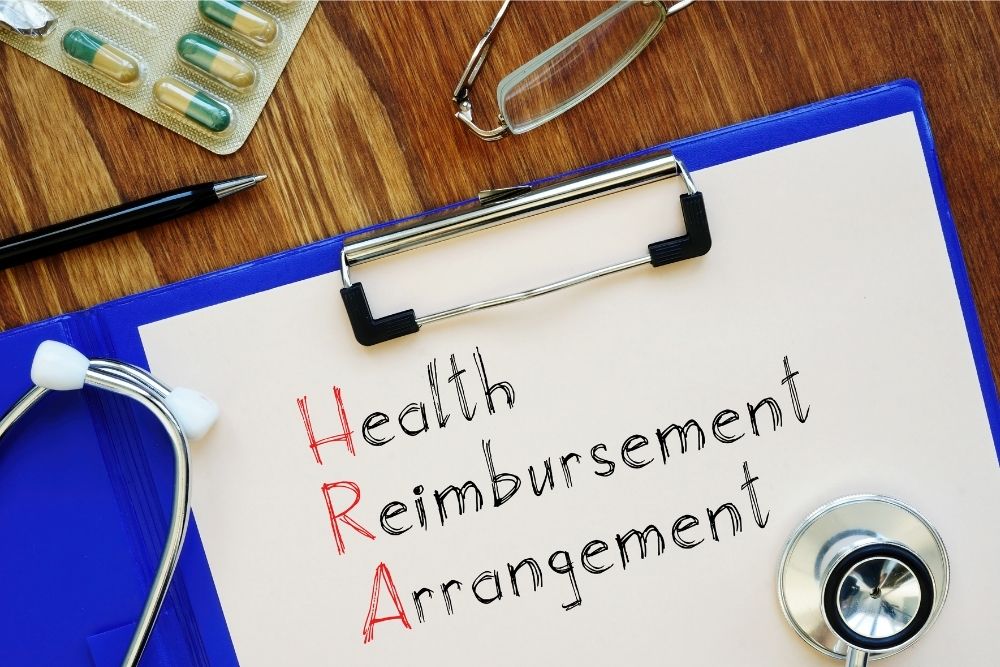
Has your employer recently added a Health Reimbursement Arrangement or HRA as part of your group health insurance program?
If you’re new to HRAs, you might be confused about it. You probably have questions about how to use your HRA.
As an employee benefits broker, I help my clients’ employees better understand how their HRA functions and how to use their HRA to cover their medical expenses practically.
Here are the six questions I cover when I explain this group health arrangement:
- What is an HRA?
- How does an HRA work?
- What expenses can I use my HRA to cover?
- How do I access the funds from my HRA?
- Can I contribute to my HRA?
- Can I use my HRA if I switch jobs or retire?
1. What is an HRA?
An HRA is a Health Reimbursement Arrangement. It is literally an arrangement in which your employer arranges to pay for some of your medical expenses to offset your plan’s high deductible.
Your HRA will help you with your out-of-pocket medical expenses. If your employer provides an HRA for you, you most likely have a higher deductible on your group health plan.
A higher deductible health care plan is less expensive for your employer than many other group health plans. Even after contributing money to cover your out-of-pocket expenses, your employer can save money on their group health costs.
Most likely, your HRA will not cover your entire deductible. It will cover only a portion of it.
2. How does an HRA work?
To give you a simplified look at how your HRA functions, here is a general overview of how HRAs function.
- Your employer sets the amount they will reimburse you for your qualified medical expenses.
- You submit those expenses to your employer or a third-party administrator to review as you incur medical expenses.
- After the expenses are approved, you are reimbursed for the expenses.
3. What expenses can I use my HRA to cover?
Your HRA will cover your qualified medical expenses and your spouse’s and dependents’ eligible medical expenses.
These expenses may include:
- Doctor’s fees
- Prescription medications
- Hospital services not paid for by insurance
- Deductibles
- Copayments
- Coinsurance
- Dental expenses
- Vision expenses
Your employer can limit which expenses will be covered by your HRA.
For instance, some employers may limit your HRA to medical expenses only and not permit the HRA to be used for dental or vision expenses. Or, an employer may not allow the HRA to cover elective procedures like elective jaw surgery or gastric bypass surgery.
Your employer and employee benefits advisor should provide education outlining what expenses you can pay for using your HRA.
4. How do I access the funds from my HRA?
To access your HRA funds, you typically have two options:
1. Manual reimbursement
Some HRA’s require that you manually submit receipts or your EOBs (Explanation of Benefits) for reimbursement. After your submission, you will receive a paper check, or the money may be directly deposited into your bank account.
2. Using a smart card
Some HRA’s are set up with a smart card that you can use for your medical expenses. Much like a debit or credit card, you use your smart card to pay the medical cost when it is incurred. For instance, you might pay for your copay using your smart card at your doctor’s office.
Either way, it is a good idea to keep your EOBs or have online access to your EOBs to ensure that you have been reimbursed for any of your qualifying expenses.
5. Can I contribute to my HRA?
The employer fully funds HRAs. You can not make additional contributions to your HRA using personal funds.
Your employer will design your HRA and determine the maximum reimbursement amount under your HRA.
Your employer can set a different reimbursement amount for different groups of employees. For instance, your employer can set one limit for employees on a self-only health plan and a different amount for those with a family health plan.
Employees can not determine contribution amounts based on their employee’s age, length of employment, or compensation level.
In addition to the HRA, your employer may also offer a Flexible Spending Account (FSA). If this is the case, you can make contributions to your FSA.
To learn more about FSAs, check out Using an FSA (Helping Your Employees Plan for Health Care Costs)
What happens if I don’t use all the funds available through my HRA? Can I use them the next year?
You may find that you don’t use all of the funds available to you through your HRA. Depending on your employer’s arrangement, those funds may roll over in subsequent years.
For instance, let’s say that your HRA covers $500, but you are only reimbursed $150 throughout the year. What happens to the remaining $350?
The remaining $350 might roll over to the following year, providing you with $850 to be reimbursed for medical expenses in the second year of your health plan.
The remaining $350 may also become unavailable to you.
It depends on how your employer sets up the HRA. Some employers will allow for a rollover, while others will only allow you access to the funds each year.
6. Can I use my HRA if I switch jobs or retire?
Because your HRA is an arrangement or an agreement between your employer and yourself, it only functions while you remain employed with that employer. If you switch jobs within the same company, you may still qualify for an HRA.
If you move your employment to another company or stop working altogether, you will no longer qualify for your HRA.
If you qualify for COBRA, you may also be eligible to continue using your HRA. Your employer’s group health plan will expressly state if you can use your HRA while on COBRA.
You may also qualify for an HRA as a retired employee. Again, your employer’s group health plan will outline your eligibility.
My employer recently added an HRA. Where can I find information about how my HRA functions?
Every HRA functions differently. HRAs vary in how to submit your expenses, which expenses are eligible, and even in the amount available for reimbursement.
To successfully use your HRA, you will need education.
Your employee benefits broker should provide you with education about your HRA. This education may come through a video, an in-person informational meeting, printed educational materials, or online training about your HRA.
If you want to use your HRA successfully, you must engage in the educational opportunities offered regarding your group health plan.
It is also beneficial to include your spouse or dependents in the education. Your spouse or dependents will need to know how to access the HRA funds for their medical expenses.
Your spouse and dependents also need a clear understanding of which medical expenses are covered under your employer’s plan.
If you are not receiving education, you can ask your employer about providing education for your plan.
Creating an Effective Long-Term Group Health Insurance Program
If you’re an employer desiring to create an effective group health insurance program, the team at Baily Insurance Agency would love the opportunity to connect with you.
Our team works with businesses in Pennsylvania, West Virginia, Ohio, and Maryland to create a robust employee benefits program.
Our team takes a long-term approach to control group health costs. We help our clients create a benefits plan that satisfies their employees, entices new talent, and aids employers in meeting their group benefits goals.
We recognize that group benefits are not a one-size-fits-all product. Your benefits must be tailored to your business’s unique needs.
We do more than quote our client’s group health benefits. We partner with our clients and work together to create a successful benefits program.
If you’d like to talk more about what it looks like to partner with our team, please let us know by filling out the form below. If you’d rather speak to someone in person, please call us at 724.627.6121 and ask for Aaron or Leslie.
We’re looking forward to learning about your business!

